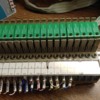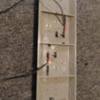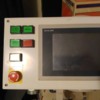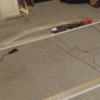This is a project I am working on. I am using an Allen-Bradley PLC unit to control a model railroad layout. This project normally would be considered impractical as there are better options out there to control a model layout. I am doing this as a learning tool to teach myself PLC programming. It is possible some of the electrical build for the layout may come in handy for some other project so there could be some useful information. I was lucky to be able to secure a large assortment of part from my prior job, they were scrapping machinery and I was able to take parts home for free.
The first thing I did was take this interface board and modify it so it can send a signal back to indicate the switch position. Most PLC and handling interface is 24 volts. I replaced the onboard resistors to 220 ohm to match the voltage given by the "RSC Lights" wire from the switch. The pictures show the switch position and the LED's on the interface board.














































